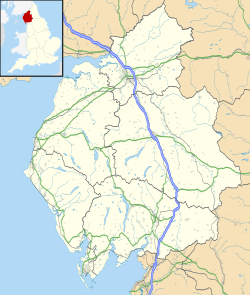Grey Croft stone circle facts for kids
| Location | Cumbria |
|---|---|
| Coordinates | 54°24′27″N 3°29′27″W / 54.4076°N 3.4908°W |
| Type | Stone circle |
| History | |
| Periods | Neolithic / Bronze Age |
The Grey Croft stone circle is an ancient monument found near Seascale in Cumbria, England. It's a special place where large stones stand in a circle. This historical site is close to the former nuclear power stations at Sellafield.
Contents
What is the Grey Croft Stone Circle?
The Grey Croft stone circle is made up of 12 large stones. It is located south of the Sellafield nuclear site. The circle is about 600 metres (or about 2,000 feet) from the sea. Today, only 10 of the original 12 stones are still standing upright. There is also a smaller, single stone located about 21 metres (or 69 feet) to the north of the main circle.
When was the Grey Croft Stone Circle Built?
The Grey Croft stone circle dates back to ancient times. It was built during the Neolithic (New Stone Age) and Bronze Age periods. These periods were thousands of years ago, long before written history began.
What is the History of the Grey Croft Stone Circle?
The stones of the Grey Croft circle have an interesting story. In 1820, a farmer who lived nearby pushed most of the stones over. He then buried them, leaving only one stone standing.
In 1949, archaeologists began to dig at the site. They carefully uncovered nine of the buried stones. These stones were then put back into their original positions as accurately as possible. This work helped to restore the ancient circle.
What Did Archaeologists Find at Grey Croft?
During the excavations, archaeologists made some exciting discoveries. They found an oval-shaped pile of stones, called a cairn, in the middle of the circle. When they dug under this cairn, they found traces of charcoal. They also found calcined bones, which are bones that have been burned.
Other finds included a broken ring made of jet or lignite. These materials are like a type of black, fossilized wood. This ring dates back to the early Bronze Age. They also found small pieces of flint and a flint scraper. Flint was often used to make tools in ancient times. Near the eastern stone of the circle, archaeologists discovered a stone axe. This axe was made from stone from Great Langdale and dates to the Late-Neolithic period. These finds help us understand the people who lived here long ago.


